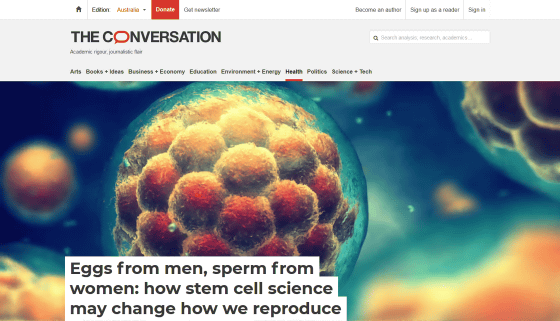What are the challenges faced when it becomes possible to produce 'male eggs' and 'female sperm' due to the development of science and technology?

Recent advances in science and technology have made it possible to create induced
Eggs from men, sperm from women: how stem cell science may change how we reproduce
https://theconversation.com/eggs-from-men-sperm-from-women-how-stem-cell-science-may-change-how-we-reproduce-219005

Until now, human reproductive activity was accomplished by fertilizing an egg produced by a woman with a sperm produced by a man and implanting it in the uterine lining, but with the advent of iPS cells, reproduction that is the opposite of the original sex The possibility of creating cells has emerged.
Many scientists believe that it is still some time before the technology to create germ cells from iPS cells can be applied to humans. However, at the time of writing the article, an experiment had already been successful in creating ``mice whose parents are both male'' by creating eggs from the somatic cells of male mice and fertilizing them.
A mouse whose parents are both male is born using eggs and sperm made from male cells - GIGAZINE

According to Coplin et al., there are three different clinical applications for the technology that creates germ cells from somatic cells. The first is 'rationalizing in vitro fertilization,' and at the time of writing the article, in vitro fertilization requires repeated hormone injections and some surgical procedures to collect eggs, so there is a risk of overstimulating the ovaries. . If it were possible to create reproductive cells from somatic cells, it may be possible to reduce the risks associated with in vitro fertilization.
The second is that it can 'avoid certain types of medical infertility.' For example, it may be possible to produce eggs using the body cells of women who were born with non-functioning ovaries or who are unable to produce eggs due to early menopause.
The third is to apply this technology to create ``male eggs'' or ``female sperm'' to ``create children for same-sex couples.'' With traditional reproductive practices, same-sex couples cannot produce children who inherit the genes of their parents, but using this technology, same-sex couples may be able to raise children who are genetically related to their parents.

Mr. Koplin and his colleagues point out that if the technology to create germ cells from human somatic cells is put into practical use, we will face the following five challenges.
◆1: Is it safe?
As with many other scientific technologies, the safety of the technology for producing germ cells from somatic cells requires repeated careful testing and rigorous monitoring. Also, since having a child is not a temporary problem, it is important to follow up on the child after it is born.
◆2: Is it fair?
If access to this technology is limited only to the wealthy, there are concerns that it will create new inequalities in the world. Injecting public funds may be helpful in resolving inequality, but in order to determine whether it is appropriate, it is necessary to go through the discussion of ``Should the state support people's reproduction?'' There may be.
◆3: Should access be restricted?
The quality and number of germ cells decline with age, so it is generally more difficult for older couples to have children, but by creating reproductive technology from somatic cells, it is theoretically possible to have fresh germ cells at any age. ” will be available. However, there is still debate as it is a heavy physical, psychological, and sociological burden for older women to become pregnant.
◆4: What to do about the issue of surrogate mothers?
Even if it were possible to take skin cells from a male same-sex couple and create eggs and sperm to create an embryo, that embryo would still need a mother to become pregnant. Even at the time of writing, there are cases in which surrogate mothers carry out pregnancy and childbirth on behalf of the client, but this involves legal, ethical, and physical difficulties.
◆5: Who is the legal parent?
With the spread of surrogacy and egg/sperm donation, the question of who is the legal parent of a child has already emerged, but if reproductive cells can be created from somatic cells, this problem will be solved. Accelerate further. Theoretically, it is possible to ``produce eggs and sperm from one person's skin cells to create a child with only one genetic parent,'' or ``produce sperm and eggs from the embryos of two couples, respectively, and combine them. It is even possible to create a child with four genetic parents, so society needs to think about legal and ethical issues.

Coplin et al. point out that the most controversial potential use of producing reproductive cells from somatic cells is ``reproduction in same-sex couples.'' Although reproductive restrictions in same-sex relationships are sometimes seen as a 'social' issue that medical professionals are not obligated to treat, the moral stakes suggest that they can be applied to both same-sex and opposite-sex couples. No matter what happens, the fundamental idea of ``helping couples who want to have children reproduce'' remains the same. Therefore, it can be seen that it is unfair to provide infertility treatment for opposite-sex couples but not same-sex couples.
Furthermore, if reproduction using germ cells created from somatic cells becomes widespread, it will become possible to select from a large number of embryos ``embryos that are more likely to develop into better children.'' In this regard, there are not only ethical issues with deliberately selecting superior embryos, but also the converse of ``choosing embryos at random when you could have chosen embryos with a high chance of a good life''. There is also a need to discuss the moral responsibility of raising children in the same environment.
'Laws and ethics can lag behind new technology, especially when the impact is as profound and far-reaching as IVF,' Coplin et al. 'We need to have a debate about whether we should do that. Given the rapid development of science, we should start this discussion now.'
Related Posts:
in Science, Posted by log1h_ik






